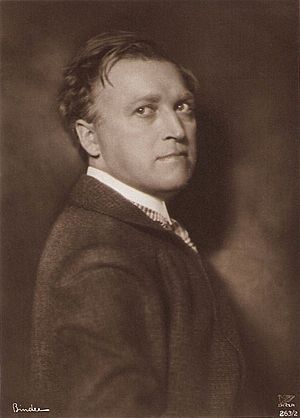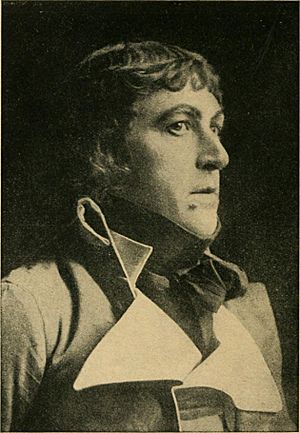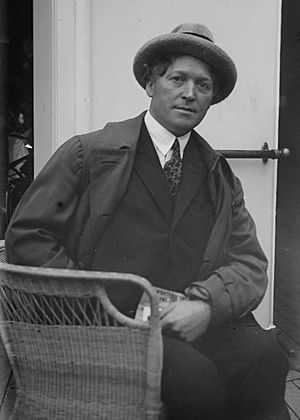Werner Krauss facts for kids
Werner Johannes Krauss (born June 23, 1884 – died October 20, 1959) was a famous German actor for both stage and film. He was one of the most important actors in Germany during the early 1900s. However, he became a controversial figure because he acted in the Nazi propaganda film Jud Süß and worked with the Nazis.
Quick facts for kids
Werner Krauss
|
|
|---|---|

Krauss about 1920
|
|
| Born |
Werner Johannes Krauß
23 June 1884 Gestungshausen, Bavaria, German Empire
|
| Died | 20 October 1959 (aged 75) |
| Occupation | Actor |
| Years active | 1902–1959 |
| Spouse(s) |
Paula Saenger
(m. 1908; div. 1930)Maria Bard
(m. 1931; div. 1940)Liselotte Graf
(m. 1940) |
| Awards | Staatsschauspieler (1934) Goethe-Medaille für Kunst und Wissenschaft (1938) Order of Merit of the Federal Republic of Germany (1954) Iffland-Ring (1954) Decoration of Honour for Services to the Republic of Austria (1955) |
Contents
Early Life and First Steps in Acting
Krauss was born in Gestungshausen, a small town in Bavaria, Germany. His grandfather was a pastor. Werner spent his childhood in Breslau. In 1901, he attended a college for teachers in Kreuzburg.
While studying, he secretly worked as an extra at the Breslau Lobe-Theater. When this was discovered, he was suspended from college. After that, he decided to become a full-time actor and joined a traveling theater group.
Becoming a Famous Actor
In 1903, Krauss performed for the first time at the Guben municipal theater. Even though he never had formal acting training, he continued to perform in many cities like Magdeburg, Nuremberg, and Munich.
In 1913, a famous theater director named Max Reinhardt invited Krauss to join his Deutsches Theater in Berlin. At first, Krauss only got smaller roles, like King Claudius in Shakespeare's Hamlet. After serving in the navy during World War I, he also started acting in films in 1916.
Film and Stage Success
Krauss's first film role was in Tales of Hoffmann in 1916. He became known for playing dark and intense characters. He gained worldwide fame for his role as the creepy Dr. Caligari in the 1920 film The Cabinet of Dr. Caligari. This movie is a key example of German Expressionism, a style of art and film.
He also played important roles in other films, such as Othello in a 1920 adaptation and Iago in a 1922 film. He appeared in Waxworks (1924), Tartuffe (1926), and The Student of Prague (1926).
In 1924, Krauss returned to the stage, joining the Prussian State Theatre in Berlin. He continued to perform in many plays, including The Captain of Köpenick in 1931. He also performed at the famous Vienna Burgtheater. His talent even took him to London and Broadway in New York City.
Krauss was so skilled at playing different characters that people called him "the man with a thousand faces." Another actress, Elisabeth Bergner, described him as "the greatest actor of all time."
During Nazi Germany
Werner Krauss supported the Nazi Party and its ideas. When the Nazis came to power in Germany in 1933, Krauss joined the Vienna Burgtheater. He met Benito Mussolini, the leader of Italy, and also Joseph Goebbels, the Nazi propaganda minister.
Krauss was appointed Vice President of the theater department of the Reichskulturkammer, a Nazi organization that controlled arts and culture. He held this position from 1933 to 1935. In 1934, he was given the title Staatsschauspieler, meaning "State Actor," which showed he was considered a very important national actor. He also signed a public statement supporting Adolf Hitler. The Nazi leaders, Goebbels and Hitler, saw Krauss as an important cultural representative for Nazi Germany.
In 1940, Krauss played six different Jewish characters in the Nazi propaganda film Jud Süß. This film was made to spread harmful ideas about Jewish people. When asked about the negative impact of his performance, he reportedly said, "that's no concern of mine – I'm an actor!" In 1943, he also played Shylock in a controversial production of The Merchant of Venice at the Burgtheater. In 1944, Krauss was put on a special list of important German artists, which meant he did not have to serve in the military.
After the War
After World War II, Krauss had to leave his home in Austria. He was also banned from performing in Germany. His films were forbidden, and he had to go through a program from 1947 to 1948 to help him understand and reject Nazi ideas. After this, he was able to return to Austria and became an Austrian citizen.
In 1950, he performed again as King Lear at the Ruhr Festival in Germany. However, his performances sometimes faced protests.
In 1951, Krauss received German citizenship again. He was eventually welcomed back to German film festivals. In 1954, he received the Iffland-Ring, a very special award for German-speaking actors. In the same year, he was given the Order of the Federal Republic of Germany, and in 1955, he received a high award from Austria. In 1958, Krauss wrote his autobiography called Das Schauspiel meines Lebens (The Play of my Life).
Werner Krauss passed away in Vienna in 1959 at the age of 75. He was buried in a special grave in the Vienna Zentralfriedhof.
Images for kids
See also
 In Spanish: Werner Krauß para niños
In Spanish: Werner Krauß para niños






